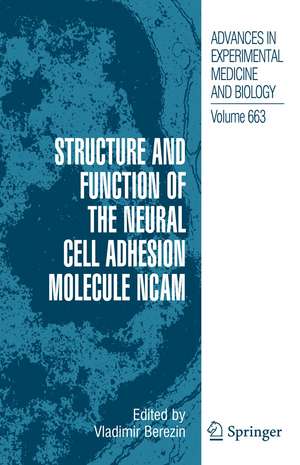Structure and Function of the Neural Cell Adhesion Molecule NCAM: Advances in Experimental Medicine and Biology, cartea 663
Editat de Vladimir Berezinen Limba Engleză Paperback – 25 feb 2012
| Toate formatele și edițiile | Preț | Express |
|---|---|---|
| Paperback (1) | 1224.06 lei 6-8 săpt. | |
| Springer – 25 feb 2012 | 1224.06 lei 6-8 săpt. | |
| Hardback (1) | 1229.10 lei 6-8 săpt. | |
| Springer – 22 dec 2009 | 1229.10 lei 6-8 săpt. |
Din seria Advances in Experimental Medicine and Biology
- 9%
 Preț: 719.56 lei
Preț: 719.56 lei - 5%
 Preț: 717.00 lei
Preț: 717.00 lei - 5%
 Preț: 717.00 lei
Preț: 717.00 lei - 15%
 Preț: 640.24 lei
Preț: 640.24 lei - 5%
 Preț: 715.71 lei
Preț: 715.71 lei - 5%
 Preț: 716.28 lei
Preț: 716.28 lei - 20%
 Preț: 691.93 lei
Preț: 691.93 lei - 5%
 Preț: 1031.00 lei
Preț: 1031.00 lei - 5%
 Preț: 820.42 lei
Preț: 820.42 lei - 5%
 Preț: 716.28 lei
Preț: 716.28 lei - 15%
 Preț: 641.38 lei
Preț: 641.38 lei - 5%
 Preț: 717.20 lei
Preț: 717.20 lei - 5%
 Preț: 715.35 lei
Preț: 715.35 lei - 5%
 Preț: 1113.83 lei
Preț: 1113.83 lei - 20%
 Preț: 1161.71 lei
Preț: 1161.71 lei - 5%
 Preț: 1170.51 lei
Preț: 1170.51 lei - 18%
 Preț: 1119.87 lei
Preț: 1119.87 lei - 5%
 Preț: 1288.48 lei
Preț: 1288.48 lei - 5%
 Preț: 1164.67 lei
Preț: 1164.67 lei - 5%
 Preț: 1101.73 lei
Preț: 1101.73 lei - 18%
 Preț: 1123.67 lei
Preț: 1123.67 lei - 5%
 Preț: 1435.64 lei
Preț: 1435.64 lei - 20%
 Preț: 1044.10 lei
Preț: 1044.10 lei - 18%
 Preț: 946.39 lei
Preț: 946.39 lei - 5%
 Preț: 292.57 lei
Preț: 292.57 lei - 18%
 Preț: 957.62 lei
Preț: 957.62 lei - 18%
 Preț: 1235.76 lei
Preț: 1235.76 lei - 5%
 Preț: 1231.55 lei
Preț: 1231.55 lei - 5%
 Preț: 1292.30 lei
Preț: 1292.30 lei - 5%
 Preț: 1102.10 lei
Preț: 1102.10 lei - 18%
 Preț: 1132.81 lei
Preț: 1132.81 lei - 5%
 Preț: 1165.19 lei
Preț: 1165.19 lei - 5%
 Preț: 1418.48 lei
Preț: 1418.48 lei - 5%
 Preț: 1305.63 lei
Preț: 1305.63 lei - 18%
 Preț: 1417.72 lei
Preț: 1417.72 lei - 18%
 Preț: 1412.99 lei
Preț: 1412.99 lei - 24%
 Preț: 806.15 lei
Preț: 806.15 lei - 18%
 Preț: 1243.29 lei
Preț: 1243.29 lei - 5%
 Preț: 1429.44 lei
Preț: 1429.44 lei - 5%
 Preț: 1618.70 lei
Preț: 1618.70 lei - 5%
 Preț: 1305.12 lei
Preț: 1305.12 lei - 18%
 Preț: 1124.92 lei
Preț: 1124.92 lei - 5%
 Preț: 1097.54 lei
Preț: 1097.54 lei - 15%
 Preț: 649.87 lei
Preț: 649.87 lei - 5%
 Preț: 1097.54 lei
Preț: 1097.54 lei - 18%
 Preț: 945.79 lei
Preț: 945.79 lei - 5%
 Preț: 1123.13 lei
Preț: 1123.13 lei - 20%
 Preț: 816.43 lei
Preț: 816.43 lei
Preț: 1224.06 lei
Preț vechi: 1492.75 lei
-18% Nou
Puncte Express: 1836
Preț estimativ în valută:
234.22€ • 245.20$ • 193.80£
234.22€ • 245.20$ • 193.80£
Carte tipărită la comandă
Livrare economică 05-19 aprilie
Preluare comenzi: 021 569.72.76
Specificații
ISBN-13: 9781461425458
ISBN-10: 146142545X
Pagini: 452
Ilustrații: XVI, 434 p. 67 illus., 45 illus. in color.
Dimensiuni: 155 x 235 x 24 mm
Greutate: 0.63 kg
Ediția:2010
Editura: Springer
Colecția Springer
Seria Advances in Experimental Medicine and Biology
Locul publicării:New York, NY, United States
ISBN-10: 146142545X
Pagini: 452
Ilustrații: XVI, 434 p. 67 illus., 45 illus. in color.
Dimensiuni: 155 x 235 x 24 mm
Greutate: 0.63 kg
Ediția:2010
Editura: Springer
Colecția Springer
Seria Advances in Experimental Medicine and Biology
Locul publicării:New York, NY, United States
Public țintă
ResearchCuprins
Structure and Ligands of NCAM.- Structural Biology of NCAM.- Extracellular Protein Interactions Mediated by the Neural Cell Adhesion Molecule, NCAM: Heterophilic Interactions Between NCAM and Cell Adhesion Molecules, Extracellular Matrix Proteins, and Viruses.- Intracelluar Ligands of NCAM.- NCAM and the FGF-Receptor.- The Role of ATP in the Regulation of NCAM Function.- NCAM and Polysialic Acid.- Polysialylation of NCAM.- Structural Basis for the Polysialylation of the Neural Cell Adhesion Molecule.- The Role of PSA-NCAM in Adult Neurogenesis.- Use of PSA-NCAM in Repair of the Central Nervous System.- NCAM-mediated Signal Transduction.- Signaling Pathways Involved in NCAM-Induced Neurite Outgrowth.- Role of the Growth-Associated Protein GAP-43 in NCAM-Mediated Neurite Outgrowth.- The Neural Cell Adhesion Molecule NCAM and Lipid Rafts.- The Neural Cell Adhesion Molecule and Epidermal Growth Factor Receptor: Signaling Crosstalk.- NCAM Metabolism.- Biosynthesis of NCAM.- Soluble NCAM.- NCAM, Synapses, Emotions, and Memory.- Role of NCAM in Spine Dynamics and Synaptogenesis.- NCAM in Long-Term Potentiation and Learning.- Role of NCAM in Emotion and Learning.- NCAM in Disease.- NCAM in Neuropsychiatric and Neurodegenerative Disorders.- Neural Cell Adhesion Molecule in Cancer: Expression and Mechanisms.- Pharmacology of NCAM: NCAM Mimetics.- NCAM Mimetic Peptides: An Update.- Synthetic NCAM-Derived Ligands of the Fibroblast Growth Factor Receptor.- Dendritic Spine and Synapse Morphological Alterations Induced by a Neural Cell Adhesion Molecule Mimetic.- Orthologs and Paralogs of NCAM.- Fasciclin II: The NCAM Ortholog in Drosophila melanogaster.- The Neural Cell Adhesion Molecule NCAM2/OCAM/RNCAM, a Close Relative to NCAM.- Conclusion.- Honoring Dr. Elisabeth Bock.
Textul de pe ultima copertă
Adhesive interactions are important for cell trafficking, differentiation, function and tissue formation. In the nervous system, many cell adhesion molecules (CAMs) are involved in migration of neuroblasts, outgrowth and fasciculation of neuronal processes, formation of synapses and rearrangements of synaptic contacts associated with plasticity including learning and memory. More than eighty CAMs were found to be localized at synaptic sites, where they in a regulated manner bridge pre- and postsynaptic specializations thereby modulating synaptic function. Structure and Function of the Neural Cell Adhesion Molecule NCAM describes recent developments concerning structural, functional and possible therapeutic aspects of one particular CAM, the neural cell adhesion molecule (NCAM). NCAM is one of the first identified and most studied CAMs, and this book is the first attempt to collectively summarize our current knowledge of this important cell adhesion molecule.
Caracteristici
Introduction to current knowledge of extracellular and intracellular NCAM ligands and the structural basis of NCAM interactions with the fibroblast growth factor (FGF) receptor Chapters are grouped into sections reflecting various aspects of NCAM structure and function, making for a straightforward approach to NCAM Explores new therapeutic potential of NCAM mimetics













